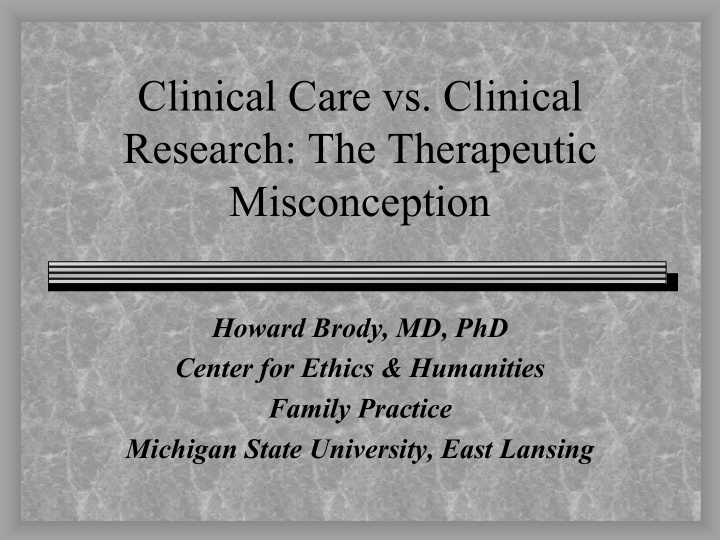



Clinical Care vs. Clinical Research: The Therapeutic Misconception Howard Brody, MD, PhD Center for Ethics & Humanities Family Practice Michigan State University, East Lansing
A Personal Anecdote
A Personal Anecdote INVESTI- DOC GATOR
Clinical Research and Clinical Therapy: Two Stances • Similarity Position: Ethics of research should be based on the ethics of therapeutic medicine • Difference Position: The two activities are fundamentally different and require different ethical approaches – Miller & Brody, Hastings Cen Rep 33(3):19, 2003
R. Levine, 1979 • An expert physician-investigator in 1970: • “Every time a physician administers a drug to a patient, he is in a sense performing an experiment.” – Hastings Cen Rep 9(3):21, 1979
National Commission, 1978 • One may perform experimentation in either the research or the therapeutic setting • But experiment does not equal research • The worlds of research and therapy are in fact quite distinct and separate – Levine, Hastings Cen Rep 9(3):21, 1979
World of Therapeutic Medicine • Goal: provide benefit to the individual patient • Ethical principles: – Therapeutic beneficence – Therapeutic nonmaleficence • Any new knowledge generated is incidental to overriding goal of activity
World of Clinical Research • Goal: New knowledge that can help future patients (generalizable) • Ethical principles – Autonomy – Nonmaleficence – Utilitarian balancing of risks and benefits • Therapeutic benefit to individual is secondary to overriding goal
Example: Depression Treatment • 200 patients with depression • Choose an antidepressant for each based on individual characteristics • Alter doses according to individual responses • Use concomitant meds (or not) based on symptoms • After 12 weeks: wide variation
Example: Depression Trial • Randomize subjects to antidepressant A or B • Probably use standardized doses • Alter doses (if at all) according to rigid schedule • Avoid any concomitant medications • Goal: Maximum uniformity at 12 weeks
Importance of National Commission (Belmont Report, 1978) • Laid groundwork for entire apparatus of institutional review of research • Logic of review by an outside body is predicated on the distinction between research and therapy (as opposed to trusting the “personal physician’s” good intentions and professionalism)
Implications for Informed Consent • Informed consent a major ethical requirement for research • Informed consent should start with a clear orientation to what sort of setting one is in • The patient-subject who thinks he is getting individualized therapy when in fact he is being treated according to a research protocol cannot give informed consent
Implications for Informed Consent-II • Blurring the distinction between research and therapy (e.g., similarity position) risks undermining the entire process of informed consent
Therapeutic Misconception • Research subject’s belief that enrolling in research trial will (with certainty) provide direct therapeutic benefit, despite what appears to be an adequate informed consent process • 40-80% of subjects showed basic misunderstandings of research trial design – Appelbaum et al., Hast Cen Rep 17(2):20, 1987
Have Things Improved? • “Our current research suggests that as many as 70% of subjects in a wide variety of clinical research studies may suffer from a therapeutic misconception.” – Appelbaum, AJOB 2(2):22, 2002
Where Does the Misconception Originate? • Assumption: subject’s psychological need for an effective cure for her disease, despite honest effort at informed consent • If investigator confuses clinical research with clinical therapy, stage is set for subject to get erroneous impression as to basic nature of the setting and activity
The Problem of Clinical Equipoise (CE) • Similarity Position yields “RCT dilemma” – How can randomization be justified within a therapeutic ethic? • CE is an attempt to answer the RCT dilemma – RCT is ethical only if the medical community is genuinely uncertain which of two treatment arms is superior
Clinical Equipoise-II • CE claims the virtue of preserving the basic duty of therapeutic beneficence – No subject randomized to a treatment known to be inferior • Therefore, CE exemplifies and logically implies the Similarity Position – The Difference Position deals with the “RCT dilemma” by rejecting it as false
Clinical Equipoise-III • “The Declaration of Geneva …binds the physician with the words, ‘The health of my patient will be my first consideration.’” • “The primary purpose of medical research…is to improve prophylactic, diagnostic and therapeutic procedures and the understanding of the aetiology and pathogenesis of disease.” – Declaration of Helsinki, WMA, 2000
Clinical Equipoise-IV • CE promotes the therapeutic misconception at all levels (subject, investigator, IRB) • CE promotes the larger misconception that both physicians and research studies are nothing but retail pharmacies – Focuses solely on what treatment is received, not how the setting is designed or how treatment decisions are made
Conclusions • Solid understanding of research ethics requires the clear distinction between research and therapeutic contexts (Difference Position) • Therapeutic misconception is a major practical problem in research
Conclusions--II • Blurring the research/therapy distinction (Similarity Position, CE) seems highly likely to worsen the therapeutic misconception problem • Many statements of research ethics today are incoherent and don’t know it (e.g., Declaration of Helsinki)
Recommend
More recommend